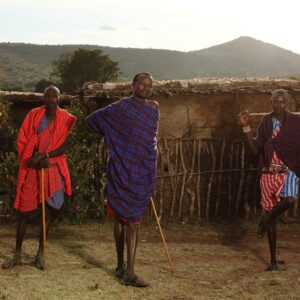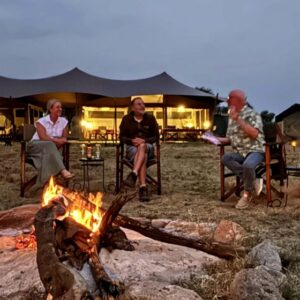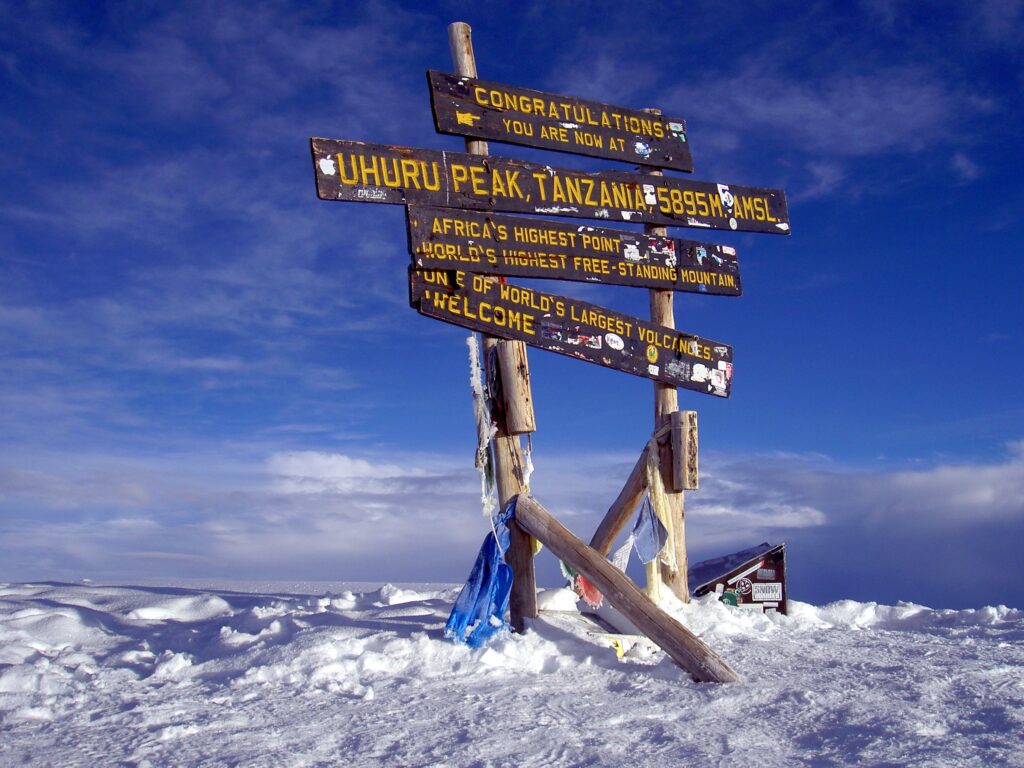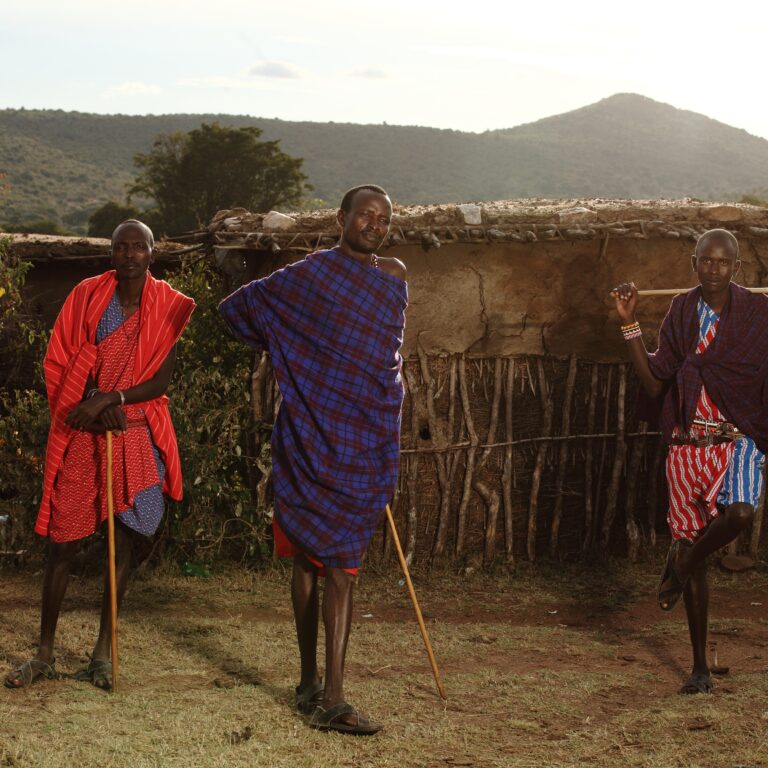A walking safari in Tanzania is one of the most authentic and exhilarating ways to experience Africa’s wilderness. Unlike traditional game drives where you observe wildlife from the comfort of a vehicle. Walking safaris invite you to step directly into nature’s rhythm — to feel the crunch of dry grass beneath your boots, to smell the earth after rain, and to listen to the rustle of unseen creatures moving through the bush. Here, every sense comes alive.
Tanzania is one of the best destinations in Africa to embark on a walking safari. Its diverse ecosystems — from sprawling savannahs and ancient craters to lush wetlands and miombo woodlands — create a perfect setting for exploring on foot. Guided by experienced rangers and trackers, you can safely approach wildlife. Discover the hidden secrets of the land, and gain a deeper appreciation of nature’s intricate web of life.
Below, we explore the best places for walking safaris in Tanzania, what to expect on this extraordinary adventure, and the key considerations to help you plan the perfect walking experience.
Where to Go for a Walking Safari in Tanzania
You can go on a walking safari in Tanzania at several locations. Including Tarangire, Serengeti, and Ruaha National Parks, as well as the Ngorongoro Crater and Nyerere National Park. Each African walking safari offers a unique experience. From following large elephant herds in Tarangire and walking the Serengeti’s vast plains to exploring the immense caldera of Ngorongoro and the remote landscapes of Nyerere. Arusha National Park is another great option, particularly for shorter walks with views of Mount Meru and diverse habitats.
Nyerere National Park (Formerly Selous Game Reserve)
Nyerere National Park — Africa’s largest protected area — is a walking safari paradise. Vast, wild, and wonderfully remote, this UNESCO World Heritage Site stretches over 30,000 square kilometers of pristine wilderness. The Rufiji River snakes its way through the landscape. Norishing palm-fringed channels, grassy floodplains, and acacia woodlands teeming with life.
Walking safaris here are immersive and adventurous. Accompanied by armed guides, you’ll trace animal tracks across the sand, identify plants used in traditional medicine, and listen to the echo of distant lions calling across the plain. Elephant herds, giraffes, and buffalo often appear in the distance, and your guide may pause to point out smaller but fascinating details — a dung beetle rolling its prize, or a leopard’s paw print imprinted in the soft earth.
The combination of riverine beauty, solitude, and abundant wildlife makes Nyerere one of Tanzania’s most rewarding destinations for walking safaris.
Ruaha National Park
If there’s one place in Tanzania that embodies raw wilderness, it’s Ruaha National Park. Located in the heart of the country. Ruaha is Tanzania’s largest national park and remains blissfully untouched by mass tourism. The landscape is dramatic — a blend of rugged hills, baobab-studded plains, and the meandering Great Ruaha River, which serves as a lifeline for countless animals.
A walking safari in Ruaha reveals the park’s quieter, more mysterious side. Here, it’s not just about spotting the Big Five. It’s about learning how the bush works. Your guide might stop to show you how to tell the age of elephant tracks. Explain the purpose of termite mounds, or identify the calls of birds overhead. The experience is slow, deliberate, and deeply rewarding.
Ruaha is home to large populations of elephants, lions, leopards, and even wild dogs. While encounters with big game on foot are possible. Walks are designed to prioritize safety and respect for wildlife. The result is a genuine connection to the landscape — one that lingers long after you’ve left.
Tarangire National Park
Known for its magnificent baobab trees and vast herds of elephants. Tarangire National Park best safari destinations in East Africa you can’t miss for walking safari vacations offers some of northern Tanzania’s best walking safari experiences. The African Walking Safari Experience park’s mix of woodland, riverine forest, and open plains provides a diverse backdrop for exploration.
Walking safaris here allow you to experience the park beyond its famous elephant herds. You’ll get close to the smaller wonders — colorful lizards basking on rocks, the scent of crushed sage underfoot, or weaver birds building intricate nests. The Tarangire River attracts a variety of wildlife, making it a hotspot for animal sightings. Especially during the dry season when water sources are scarce.
The park’s proximity to Arusha also makes it ideal for travelers who want to include a short walking safari as part of a longer northern circuit itinerary.
Arusha National Park
Often overlooked in favor of Tanzania’s larger reserves. Arusha National Park offers an extraordinary walking safari experience within easy reach of Arusha town. It’s one of the few parks in the country where walking is a primary activity — not just an add-on.
Here, you can hike through lush montane forests at the base of Mount Meru, wander along the tranquil Momella Lakes, and cross open grasslands dotted with giraffes, zebras, and warthogs. The park is also a birdwatcher’s paradise, home to flamingos, turacos, and countless other species.
What makes walking in Arusha National Park truly special is the scenery — from volcanic craters to dense forests alive with the chatter of colobus monkeys. Walking safari in Tanzania it’s a peaceful yet thrilling way to start or end a Tanzanian safari adventure.
Ngorongoro Highlands
For travelers seeking a more adventurous trek, the Ngorongoro Highlands provide a spectacular backdrop. Unlike the crater floor — where walking is restricted due to high predator density — the highlands surrounding the crater are open for exploration.
Guided walking safaris in Africa, walks here lead through rolling hills, forests, and Maasai villages, offering a unique blend of wildlife, culture, and scenery. You might trek from Empakaai Crater, known for its flamingo-filled lake, to the rim of Olmoti Crater or even on multi-day routes that descend toward the Serengeti Plains.
This walking & trekking safari in Tanzania region’s beauty lies in its contrasts — misty mountain trails, traditional Maasai bomas, and sweeping views across volcanic landscapes. Walking here feels like stepping back in time, into a world where people and wildlife have coexisted for centuries.
Tip: You can take a walking tour on the Ngorongoro Crater rim, which offers a different perspective than a vehicle safari by providing breathtaking views and a more intimate experience with the landscape. These tours are often booked by guests who want to explore the area differently after a traditional safari. They allow you to appreciate smaller details, interpret animal tracks, and enjoy panoramic views. Walking safaris can be booked as part of a safari package through tour operators like Foot Slopes Tours and Safaris in East Africa.
Serengeti National Park
While the Serengeti is famous for its vast plains and the Great Migration, few travelers realize. It’s also possible to explore certain parts of the park on foot. Walking safaris in the Serengeti are conducted in specially designated wilderness areas, away from the busiest tourist routes.
Here, you can follow the same ancient paths used by animals for generations. Your guide might lead you along riverbanks. Through acacia groves, pointing out animal signs that most visitors miss — claw marks on a tree, a freshly dug aardvark burrow, or the tracks of a migrating herd.
These walks provide a completely different perspective of the Serengeti. Instead of watching from afar, you’re immersed in the ecosystem — hearing the rustle of grass, smelling the wild sage, and feeling the pulse of nature up close.
What to Expect on a Walking Safari
On a walking safari, expect a deeply immersive experience that engages all your senses. Led by expert guides who prioritize safety and share their knowledge of the environment. While you may get closer to wildlife like elephants, giraffes, and antelopes, the focus is on the smaller details of nature, such as tracks and plants, rather than just large animal sightings. Be prepared for physical activity and always follow your guide’s instructions closely to ensure a safe and unforgettable adventure.
Intimate Connection
A walking safari is about intimacy — not distance. Without the hum of an engine or the confines of a vehicle, you experience the wilderness in its purest form. Every sound is amplified: the buzzing of cicadas, the distant bark of a baboon, or the rhythmic beat of your own footsteps.
This closeness fosters a deep connection with nature. You begin to notice how everything is interlinked — how an acacia tree shelters ants, which in turn protect it from grazers; how the wind carries scents that reveal the presence of predators. The bush becomes a living classroom, and you its humble student.
Expert Guidance
Walking safaris in Tanzania are always led by highly trained guides and armed rangers. These experts have an intimate understanding of the environment and the behavior of wildlife. They know how to read the bush — identifying fresh tracks. Recognizing alarm calls, and ensuring guests remain safe at all times.
Your guide is not just a protector, but also a storyteller. They interpret the landscape, sharing ancient knowledge and scientific insights that transform your walk into an unforgettable learning experience. Many guides are locals who grew up in the region, and their stories add an authentic cultural dimension to the safari.
Focus on Small Details
Unlike game drives that focus on big game, walking safaris encourage you to slow down and appreciate the small details that bring the ecosystem to life. You’ll see termite mounds, dung beetles at work, or the delicate tracks of mongoose crisscrossing the sand.
Guides often point out medicinal plants, animal droppings, or the intricacies of bird behavior. Each discovery adds a layer of understanding — a reminder that even the tiniest creature plays a role in maintaining balance in the wild.
Wildlife Encounters
While walking safaris aren’t primarily about chasing the Big Five. Wildlife encounters are common — and always thrilling. You might watch a herd of elephants browsing peacefully nearby, or spot giraffes moving silently across the plain. Sometimes, you’ll come across buffalo or even lions at a safe distance. Their raw presence both humbling and awe-inspiring.
Because you’re on foot, animals react differently — often curious rather than threatened. Your guide will ensure you approach respectfully and maintain a safe distance. Every encounter, big or small, feels more personal and authentic than it ever could from a vehicle.
Variety of Experiences
Walking safaris in Tanzania can range from short guided nature walks around lodges to multi-day treks through remote wilderness. Some lodges offer morning or afternoon walks as part of their daily schedule. While others specialize in immersive mobile walking safaris that follow wildlife corridors and camp under the stars.
You can choose to explore volcanic craters, riverbanks, forests, or open plains — each offering a unique sensory experience. For photographers and nature enthusiasts, walking safaris are especially rewarding, as they allow more time to observe and capture the subtle moments of the wild.
Key Considerations for a Walking Safari
Key considerations for a walking safari include adhering strictly to guide instructions and safety protocols, such as walking in a single file and staying quiet. You should also pack appropriately by wearing neutral-colored, lightweight clothing and sturdy, broken-in hiking boots, and bring essentials like sunscreen, insect repellent, a hat, and plenty of water. Preparing for physical exertion and understanding local health risks are also important aspects of planning.
Booking
When booking a walking safari, it’s essential to choose a reputable operator with experienced guides and proper permits. Not all areas in Tanzania allow walking, and those that do require guides certified by the Tanzania National Parks Authority (TANAPA). Decide what type of experience you want — a short walk, a full-day trek, or a multi-day wilderness journey — and book accordingly. Some lodges have in-house guides and walking concessions. While others collaborate with specialized walking safari operators.
Booking well in advance is recommended, especially during peak seasons (June to October), as walking safaris are limited to small groups to ensure exclusivity and minimize environmental impact.
Safety
Safety is paramount on any walking safari. Always follow your guide’s instructions — their knowledge and instincts are your best protection. Guides are trained to read animal behavior and will know when to approach, when to wait, and when to retreat. You’ll be briefed before each walk on how to behave around wildlife. For example, maintaining silence, avoiding sudden movements, and walking in a single file are key practices. The presence of an armed ranger provides an additional layer of security, though encounters with dangerous animals are rare and handled calmly.
Wear neutral-colored clothing (khaki, green, or brown), sturdy walking boots, and a wide-brimmed hat. Carry sunscreen, water, and a camera — but remember, walking safaris are more about presence than pictures.
Best Times to Go
The best time for a walking safari in Tanzania is during the dry season (June to October). During this period, vegetation is thinner, visibility is better, and wildlife tends to congregate around water sources, increasing your chances of sightings. Trails are also easier to navigate, and the weather is generally pleasant.
However, some parks, such as Nyerere and Ruaha, also offer beautiful walking experiences during the green season (November to March) when landscapes are lush, birdlife is abundant, and fewer tourists are around. Each season offers its own magic — the dry season for game visibility, and the green season for scenery and tranquility.
Best camps & lodges for walking safaris in Tanzania
Some of the best walking safari lodges in Tanzania include Jabali Ridge in Ruaha National Park, The Highlands Camp, and Entamanu Ngorongoro in the Ngorongoro Conservation Area, best walking safari Lodges in Africa, Kuro Tarangire camp, Tarangire Safari lodge, and Roho ya Selous in Nyerere National Park. Other excellent options for guided walks in various locations include Kichaka Camp in Ruaha and Serengeti Green Camp in the Serengeti.
Ultimate walking Safari guide: Walking safaris can be customized for various groups, including families, couples, and seniors, with options for private tours, luxury, or budget-friendly holidays. Companies offer activities like guided walks with expert guides who tailor the experience to the group’s abilities and interests. Reviews and photos are often available through the tour operator website, Foot Slopes Tours and Safaris travel site to help with planning. Custom maps can be provided by tour operators for planning your specific holiday route.
The Expert Guide to Walking Safaris
A walking safari offers a deeper connection with nature by allowing you to experience the wilderness on foot with a knowledgeable guide. To prepare, pack neutral-colored, breathable clothing, sturdy walking shoes, a hat, and high-SPF sunscreen to protect yourself from the sun. The finest collection of Walking Safaris in Africa. Always listen to your guide, who will prioritize your safety while you explore details missed from a vehicle, like animal tracks and plants.
Tips: Luxury and tailor-made walking safaris combine personalized adventure with high-end accommodations to provide an intimate wildlife experience. These best walking safaris in Africa experiences trips are customized to your desired level of activity and style, featuring expert guides who can lead you to unique wildlife encounters while you explore the wilderness on foot, with luxury lodges and camps providing comfort and service.
8 things that should be on your Tanzania itinerary
The Best Places to See Wildlife in Tanzania
What to Expect on a Walking Safari in Africa
Complete Guide To Walking Safari in Tanzania
1 Week Tanzania Safari Itinerary (Ultimate guide & Costs)
Serengeti Walking Safari: The Ultimate Guide to Tanzania’s Most Immersive Wildlife Experience
What occurs on a walking safari in Tanzania?
A walking safari in Tanzania involves a guided, immersive experience on foot to explore wildlife and landscapes up close. You’ll learn to read animal tracks, identify plants, and understand the ecosystem while moving at a slower pace. Led by expert guides and often an armed ranger, it focuses on smaller details and can include encounters with larger animals like elephants and buffalo.
The Ultimate Guide to Walking Safaris in Tanzania
A walking safari in Tanzania offers an intimate, immersive experience with nature, focusing on observation and tracking in smaller groups, typically 2-4 hours with experienced and often armed guides. To prepare, pack light, breathable clothing in neutral colors, wear broken-in walking shoes, bring sun protection, insect repellent, and binoculars, and carry a small backpack with water and snacks. The best time is generally the dry season (June-October) for easier movement and better wildlife viewing, though the green season (November-May) offers lush landscapes and fewer crowds.
Everything You Need to Know About Walking Safaris in Tanzania
Walking safaris in Tanzania provide an intimate, guided experience of wildlife and nature on foot, with safety prioritized through strict guidelines, including following your guide, wearing neutral-colored clothing, and maintaining a safe distance from animals. Key considerations include packing light, wearing appropriate footwear, and booking through a reputable, licensed operator to ensure safety and quality.
What to Expect on a Walking Safari in Tanzania?
On a walking safari in Tanzania, expect a slower, more immersive experience focused on the smaller details of the ecosystem with expert guides and armed rangers. During the best walking safaris in Tanzania
You will learn about tracking, plant life, and animal behavior while walking for a few hours, getting closer to wildlife such as giraffes and zebras, and experiencing the sights, sounds, and smells of the bush. Be prepared to dress in layers and wear sturdy, closed-toe shoes.
Top Places to Go on a Walking Safari in East Africa
The top-most popular walking safari destinations in East Africa include the Serengeti and Nyerere National Park in Tanzania, known for their vast wilderness and diverse wildlife. Embark on a walking safari through East Africa’s wild heart. In Arusha National Park, a top destinations for a walking safari in Africa, stroll amid lush forests and Mount Meru’s slopes. Tarangire National Park, where to go on a walking safari in Africa, offers up-close views of elephants and ancient baobabs. The Ngorongoro Crater reveals dramatic landscapes and diverse wildlife on foot. In the Serengeti, experience thrilling encounters with grazing herds and predators. Meanwhile, for a more remote experience, consider Tanzania’s Ruaha National Park and Nyerere National Parks (formerly Selous) immerse you in remote, untamed wilderness—where each step unveils Africa’s raw beauty, guided by expert rangers.
Should I go on a walking safari in Tanzania? Is it worth it?
Yes, you should go on a walking safari in Tanzania if you want a deeper, more immersive, and adventurous wildlife experience. It is worth it for those seeking a different perspective, as it allows you to experience the environment through all your senses, appreciate smaller details like animal tracks and plants, and have a more tranquil connection with nature. It is an ideal alternative to a game drive for those who enjoy physical activity and a sense of adventure.
Conclusion: Step into the Heart of Africa
A walking safari in Tanzania is not just an activity — it’s a journey into the soul of the wild. It’s about slowing down, engaging your senses, and rediscovering the ancient connection between humans and nature. From the floodplains of Nyerere and the rugged beauty of Ruaha to the volcanic highlands of Ngorongoro and the legendary plains of the Serengeti, each step brings new stories, lessons, and moments of awe.
Whether you’re a seasoned traveler or a first-time visitor to Africa, a walking safari offers something profoundly different — a reminder that true adventure lies not in how far you travel, but in how deeply you experience the world around you. So lace up your boots, follow your guide’s lead, and step quietly into Tanzania’s untamed wilderness. The bush awaits — wild, alive, and unforgettable.








